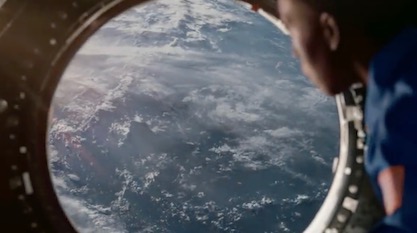 Physics, Earth & Space
Physics, Earth & Space
New Cosmos Episodes: Only Part of the Story


The third season of Cosmos, with Neil deGrasse Tyson, released its third and fourth episodes Monday night on Fox and National Geographic. The season’s theme, “Possible Worlds,” must have seemed poignant to some viewers amidst a national shutdown as they thought about what kind of possible world we are all entering together. As noted here already, these episodes will slip in smoothly in public school science classrooms, someday when all the schools reopen. So how does the information on offer measure up?
What about Biological Information?
Episodes 3, “Lost City of Life,” quickly summarizes the origins of the Milky Way galaxy, the elements, and the Earth. Tyson takes us in his “ship of the imagination” to the deep sea on the early Earth. He offers the viewer a close examination of the deep sea hydrothermal vents and towering “black smoker” chimneys, which he poetically describes as lost cities. A natural chemical energy gradient between the alkaline interior of the chimney and the acidic ocean water on the outside is supposed to power life processes and lead to the formation of the first cells. He claims this is the most plausible theory for the origin of life (OOL). As in his previous discussions of the OOL, Tyson never brings up biological information as an issue.
He offers no hint of controversy among leading OOL scientists. This is a disservice to the viewer. For balance, we recommend the expanded edition of The Mystery of Life’s Origin. One leading OOL researcher who disagrees with the vents origin scenario wrote:
A requirement for ultraviolet irradiation to generate hydrated electrons would rule out deep sea environments. This, along with strong bioenergetic and structural arguments, suggests that the idea that life originated at vents should, like the vents themselves, remain “In the deep bosom of the ocean buried.” The chemistry places certain demands on the environment of the early Earth: for example, the high concentrations of certain species through evaporation of solutions.
(John D. Sutherland, “Studies on the Origin of Life — the End of the Beginning,” Nature Reviews Chemistry 1, no. 12 (2017): 2)
Onward to Enceladus
We begin to understand perhaps why Tyson sides with the “vents” OOL scenario when he takes us to Enceladus, a moon of Saturn with ice-water geysers and a subsurface ocean. Admitting that it is speculation, he then takes us in his ship to the depths of its ocean where we witness the hydrothermal vents that are creating life there once again. Life on Earth is not special. It is just what chemistry does throughout the universe when the not-so-rare conditions are met. Tyson says, “We think we are the story, for all we know we are just the by-product of geochemical processes throughout the cosmos.”
In this episode, Tyson also covers the Cambrian explosion. He admits that we don’t have all the answers yet but then offers some speculative explanations, such as the rise of oxygen. Stephen Meyer dispatches these ideas in Darwin’s Doubt.
A Glaring Error
One glaring historical error in this episode is when Tyson claims Faraday discovered Earth’s magnetic field. People have known about Earth’s magnetic field as long as there have been compasses. In 1600 William Gilbert was the first to argue that Earth behaved like a giant magnet.
There is an historical interlude concerning William, John, and Caroline Herschel. Again, no mention of their deep Christian faith. No mention either of John’s skepticism about Darwin’s theory, which he called the “law of higgledy-piggledy.”
A Historical Episode
Episode 4, “Vavilov,” is mostly a historical episode. The guiding theme is agricultural science. Darwin gets another mention, but only in that his ideas benefitted from the work of Gregor Mendel. Tyson sounds like an Internet troll when he says, “Even now there are people who are afraid of his idea.”
It is refreshing that Tyson here doesn’t try to belittle Mendel’s faith, an Augustinian friar and abbot. In fact, in one animated sequence, he is briefly shown praying in a church. Yes, people of faith can be good scientists, but you wouldn’t know that from this series so far. Every picture of Mendel we’ve seen shows him wearing his clerical collar and sometimes a cross. Any treatment of his work cannot avoid the religious connection. And, if you’re going to discuss the origin of the theory of genetics, you cannot avoid talking about Mendel. If you asked him, Tyson might argue that Mendel’s faith was merely incidental to his scientific work.
Rough Treatment
Most of this episode is devoted to Nikolai Vavilov’s life’s work in agronomy and his rough treatment by Stalin and Trofim Lysenko. Lysenko advocated a version of Lamarckism, in which characteristics acquired during an organism’s lifetime are passed down to its offspring. Tyson criticizes the explanation offered by Lamarckism to account for the giraffe’s long neck. But Darwinists haven’t done any better.
At one point Vavilov says, “My only crime is a scientific difference of opinion.” For this Vavilov suffered greatly at the hands of the Communist thugs. This could have been uttered by a modern Darwin doubter or ID proponent at a university. If only Tyson would pay one-tenth the attention to their plight at the hands of the Darwinistas.
Although Stalin is ultimately responsible for Vavilov’s suffering, notice that it was another scientist who was the instigator. Scientists can be ruthless in their treatment of dissenting colleagues.
Missing from Tyson’s treatment of the Soviet experiment is any discussion of the roles played by Marx, Darwin, and materialism in its founding. It is interesting that Lysenko convinced Stalin of his non-Mendelian ideas, but that did not change his conviction in believing in materialistic evolution. Once again, Cosmos has told only part of the story.
Image: Screenshot from the trailer for Cosmos 3.0, “Possible Worlds.”
